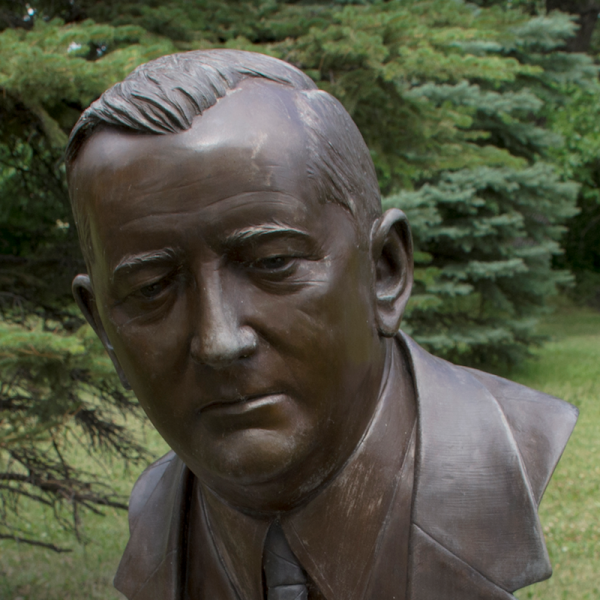The man called Intrepid
Called by the Intrepid Society as one of the greatest people ever to come out of this country, Stephenson is the true epitome of an individual who led a remarkable life with achievements and awards too numerous to mention.
He was born in 1897 in Winnipeg as William Samuel Clouston Stanger. Adopted by Vigfus and Kristin Stephenson when he was only four years old, he grew up in Point Douglas as William S. Stephenson.
Enlisted in Winnipeg’s 101st Battalion in World War I, he transferred to the Royal Flying Corps in 1917 and was credited with downing at least 16 enemy aircrafts, earning him the Military Cross. Between wars he patented wireless photography and became a wealthy industrialist in Britain. His travels through his high level business dealings in Europe gave him great insights and connections into what was happening in Germany and his own intelligence from these gatherings was communicated often to British authorities and his friend Winston Churchill.
Upon outbreak of World War 2, Prime Minister Winston Churchill invited William Stephenson to be his personal emissary to President Franklin D. Roosevelt. It became Stephenson’s task to garner favour from FDR to access the industrial might of the United States and sway public opinion to join the allied war effort. He ran a covert intelligence operation in New York City, a year prior to the U.S. entering the war. His mission was to create a secret British intelligence network throughout the Western Hemisphere and operate it very broadly on behalf of the British government and the Allies in aid of winning the war.
He became a close advisor to FDR and was instrumental in recommending friend J. ‘Wild Bill’ Donovan as the person to head up all US intelligence services. Donovan founded the US Wartime Office of Strategic Services which eventually became the Central Intelligence Agency.
Stephenson ended up overseeing a vast intelligence network which deciphered the German Enigma code, an accomplishment said by historians to have helped end the war earlier and save countless more lives. He set up what is said to be the first training school for wartime operations in North America. Around 2,000 British, Canadian and American covert operators were trained in Whitby, Ontario from 1941 to 1945.
Ian Fleming, the author of the James Bond books, was a graduate of one of his training schools in Europe and it is said Stephenson was an inspiration to his spy novels. By the end of the war, Stephenson, who acquired the code name Intrepid, was considered the single most powerful intelligence operative in the Western Hemisphere.
Although Stephenson only came back to Manitoba once after the war, he was appointed Chairman of the Manitoba Economic Advisory Board in 1959 and kept his connections with his home province for many years to come. He endowed a major scholarship at the University of Winnipeg.
Recognition and awards to be noted include his British knighthood by King George VI in 1946, the first non-US citizen to receive the Presidential Medal of Merit by President Harry Truman in 1946, Companion of the Order of Canada in 1979 presented by Governor- General Ed Schreyer, the Donovan Award by the OSS Society in 1983 aboard the USS Intrepid aircraft carrier, the Order of the Buffalo Hunt in 1985, a postage stamp in 2000 and a number of honorary degrees bestowed on him including the University of Manitoba and the University of Winnipeg.
The City of Winnipeg has done its part by renaming Water Street to William Stephenson Way, naming the new library on Keewatin St. the Sir William Stephenson Library and there is statue of Stephenson by Leo Mol on Memorial Boulevard. Smaller replicas of this statue are in places around the world such as Buckingham Palace and the CIA museum.
Here are just a few quotes acknowledging the significance of our born and raised Winnipegger.
In recommending Stephenson for knighthood, Winston Churchill wrote “This One is Dear to My Heart.”
“I want to assure you that as long as Americans value courage and freedom, there will be a special place in our hearts, our minds and our history books for the ‘Man Called Intrepid’”. Former U.S. president Ronald Reagan wrote this letter to Sir William Stephenson in 1983
“James Bond is a highly romanticized version of a true spy. The real thing is …William Stephenson” –Ian Fleming,” The Times, October 21, 1962
Finally, here is a remark from the spymaster himself after not surprisingly he became concerned about keeping peace after World War 2. It was from the speech he made in 1979 as part of his convocation acceptance for an honorary science degree from the University of Manitoba.
“It is up to us, the people, to make the moral and philosophical choices, and since the threat to humanity is the work of human beings, it is to man to save himself from himself.”

